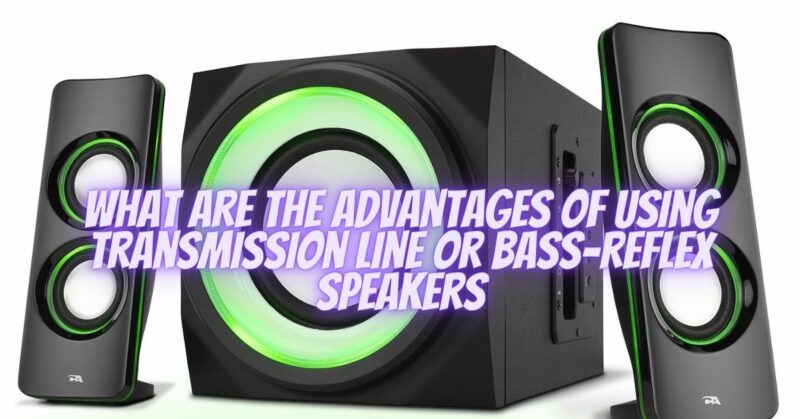When it comes to reproducing deep and impactful bass frequencies, transmission line and bass-reflex speakers are popular choices among audio enthusiasts. These speaker designs employ advanced techniques to enhance low-frequency performance, delivering extended bass response and improved efficiency. In this article, we will explore the advantages of using transmission line and bass-reflex speakers, highlighting their ability to produce deep, dynamic bass and enhance overall audio reproduction.
- Extended Bass Response:
Transmission line and bass-reflex speaker designs excel at extending the bass response, allowing for the reproduction of lower frequencies with greater clarity and depth. These designs employ specific cabinet configurations and ported systems to enhance the efficiency and output of the speaker’s low-frequency drivers.
a. Transmission Line Speakers: Transmission line speakers use a long, labyrinth-like internal pathway within the cabinet that interacts with the rear wave of the speaker driver. This design extends the low-frequency response by effectively utilizing the energy from the rear wave to reinforce and enhance the bass output.
b. Bass-Reflex Speakers: Bass-reflex speakers incorporate a tuned port or vent on the cabinet, which is carefully designed to complement the characteristics of the speaker driver. The port allows air to flow in and out of the cabinet, augmenting the low-frequency response by utilizing the back wave of the driver and enhancing its efficiency.
- Improved Efficiency and Power Handling:
Transmission line and bass-reflex speakers offer improved efficiency and power handling capabilities, making them suitable for various audio applications.
a. Enhanced Acoustic Efficiency: By utilizing the interaction of the rear wave or the ported system, these speaker designs improve the overall acoustic efficiency of the low-frequency drivers. This allows for a greater output of bass frequencies with less power input, resulting in a more dynamic and impactful listening experience.
b. Power Handling: The efficient utilization of energy and the ability to reproduce low frequencies more effectively contribute to increased power handling capabilities. Transmission line and bass-reflex speakers can handle higher power levels without distortion, enabling them to handle demanding audio signals and reproduce bass-heavy music genres with precision.
- Reduced Distortion:
Transmission line and bass-reflex designs contribute to reduced distortion in low-frequency reproduction, providing cleaner and more accurate bass performance.
a. Improved Damping: The carefully designed internal pathways or ported systems in transmission line and bass-reflex cabinets assist in damping the movement of the low-frequency driver, reducing unwanted resonances and distortions. This results in tighter, more controlled bass reproduction and minimizes distortion artifacts that can degrade the overall audio quality.
b. Reduced Cone Excursion: The enhanced efficiency and output of low frequencies in these speaker designs also contribute to reduced cone excursion. By utilizing the speaker’s energy more effectively, transmission line and bass-reflex speakers can reproduce deep bass with less excursion, resulting in improved transient response and reduced distortion.
- Size and Placement Flexibility:
Transmission line and bass-reflex speakers offer advantages in terms of size and placement flexibility:
a. Compact Designs: With their ability to reproduce deep bass from relatively compact enclosures, transmission line and bass-reflex speakers are ideal for situations where space is limited. These designs allow for more versatile placement options, making them suitable for smaller rooms or setups where larger speakers may not be practical.
b. Placement Versatility: The extended bass response and improved efficiency of transmission line and bass-reflex speakers allow for greater placement flexibility. Their ability to generate more output from the lower frequencies ensures that bass response remains robust even when placed near walls or corners, providing more options for optimal speaker positioning within a room.
Conclusion:
Transmission line and bass-reflex speakers offer significant advantages in reproducing deep, dynamic bass frequencies, enhancing the overall audio reproduction experience. With their extended bass response, improved efficiency and power handling, reduced distortion, and size/placement flexibility, these speaker designs cater to the needs of music enthusiasts, audiophiles, and professionals seeking impactful bass reproduction. Whether you enjoy rich cinematic experiences, deep bass-heavy music genres, or precise audio monitoring, transmission line and bass-reflex speakers deliver a powerful and immersive soundstage, breathing life into your favorite music and entertainment.


